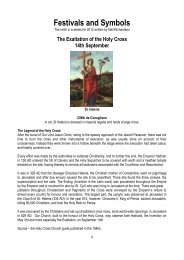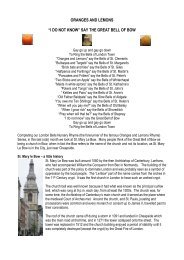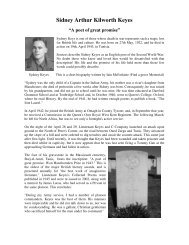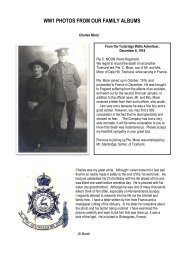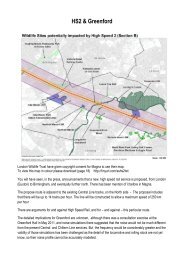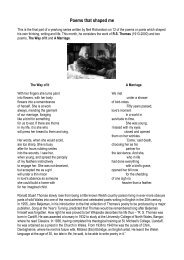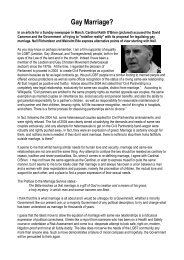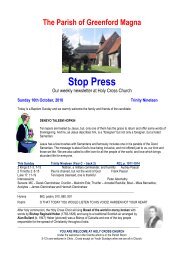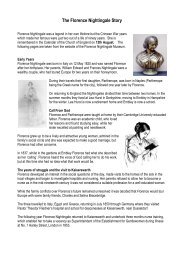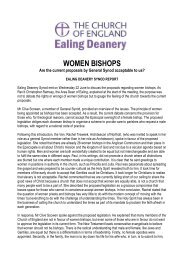Robert Andrew Eakin - The Parish of Greenford Magna
Robert Andrew Eakin - The Parish of Greenford Magna
Robert Andrew Eakin - The Parish of Greenford Magna
Create successful ePaper yourself
Turn your PDF publications into a flip-book with our unique Google optimized e-Paper software.
He must have enlisted in the army soon after as he served in the South African War and was awarded the<br />
Queen’s Medal with four clasps. He was gazetted 2 nd Lieutenant, in the Lancashire Fusiliers in June 1904, and in<br />
1908 transferred to the 1 st battalion Shropshire Light Infantry.<br />
Officers <strong>of</strong> the 1 st Battalion, King’s Shropshire Light Infantry taken in 1913. <strong>Eakin</strong> is apparently the third from the left in the<br />
middle row. (Photo courtesy <strong>of</strong> the Regimental Museum at Shrewsbury).<br />
Of his military service we know very little, save that he played military cricket, according to Wisden. His battalion<br />
was serving in Ireland when hostilities started in 1914, so for him and his colleagues on the Western Front they<br />
had come a long way from Tipperary, as the battalion left there on the 14 th August on its way to France via<br />
England.<br />
<strong>The</strong> battalion joined the 16 th Infantry Brigade and at the end <strong>of</strong> August were encamped at Grantchester near<br />
Cambridge. (If you enjoy such associations, Grantchester was for a time before the 1 st World War the home <strong>of</strong><br />
Rupert Brooke, who wrote about the “corner <strong>of</strong> a foreign field that is for ever England”, and died near Gallipoli).<br />
From there they set <strong>of</strong>f for France and were marching towards Crecy – think <strong>of</strong> the associations with wars long<br />
ago! - on 12 th September. <strong>The</strong> battalion was then engaged in some <strong>of</strong> the early encounters <strong>of</strong> the war, and it was<br />
at the battle <strong>of</strong> Le Quesne on 22 nd October that Lieutenant <strong>Eakin</strong> was one <strong>of</strong> several casualties, according the<br />
battalion’s <strong>of</strong>ficial war diary. From later information we know that his cause <strong>of</strong> death, three years later, was a<br />
gunshot wound to the head, but the nature and extent <strong>of</strong> his original injury is not recorded. However, it was <strong>of</strong><br />
sufficient severity to prevent his rejoining his regiment although he remained on the army payroll.<br />
Whilst injured he was promoted temporary captain in November that year. He was clearly unfit for further military<br />
service, but there is no evidence <strong>of</strong> when and where he was in hospital. However, he was fit enough to travel to<br />
Trinidad in February 1915, presumably to visit his father, returning in March. <strong>The</strong>re is no information about what he<br />
was doing in the period between 1915 and 1917, but he married on 5th May 1917 Kate (Kitty) Emily Phillips, aged<br />
25, the daughter <strong>of</strong> <strong>Robert</strong> William Phillips (deceased). At the time <strong>of</strong> his marriage his address was given as 83<br />
Portland Place, his wife’s as Weymouth Court, Portland Place. <strong>The</strong> wedding took place at Holy Trinity, Marylebone<br />
Road. I have not been able to find any evidence about how and where they met. When next we catch a glimpse <strong>of</strong><br />
<strong>Robert</strong>, he has died <strong>of</strong> wounds on 24 th September 1917 at the Royal Victoria Hospital, Netley, a military hospital<br />
near Southampton. His wife was apparently present at his death, which was registered at South Shoreham.



